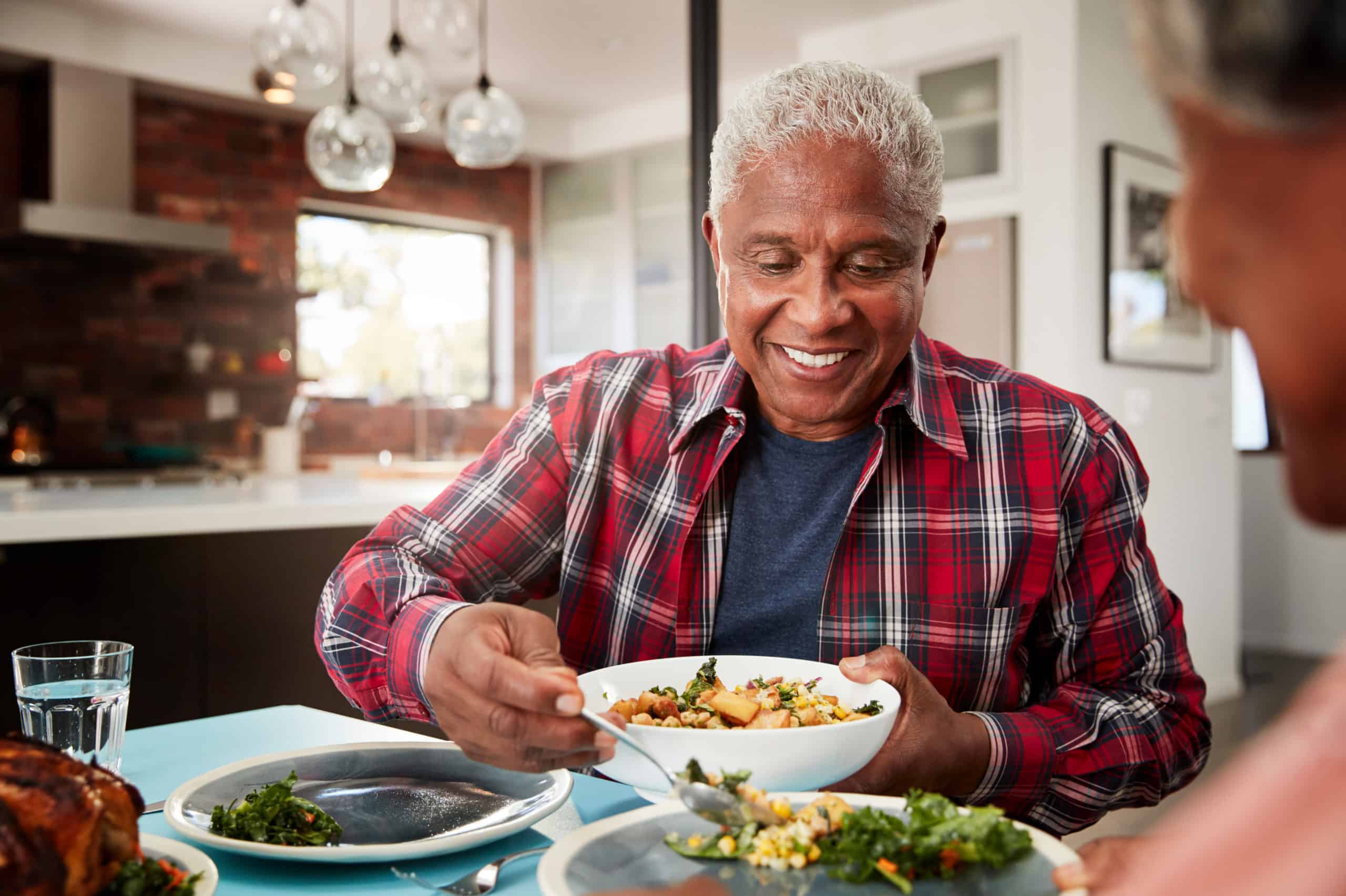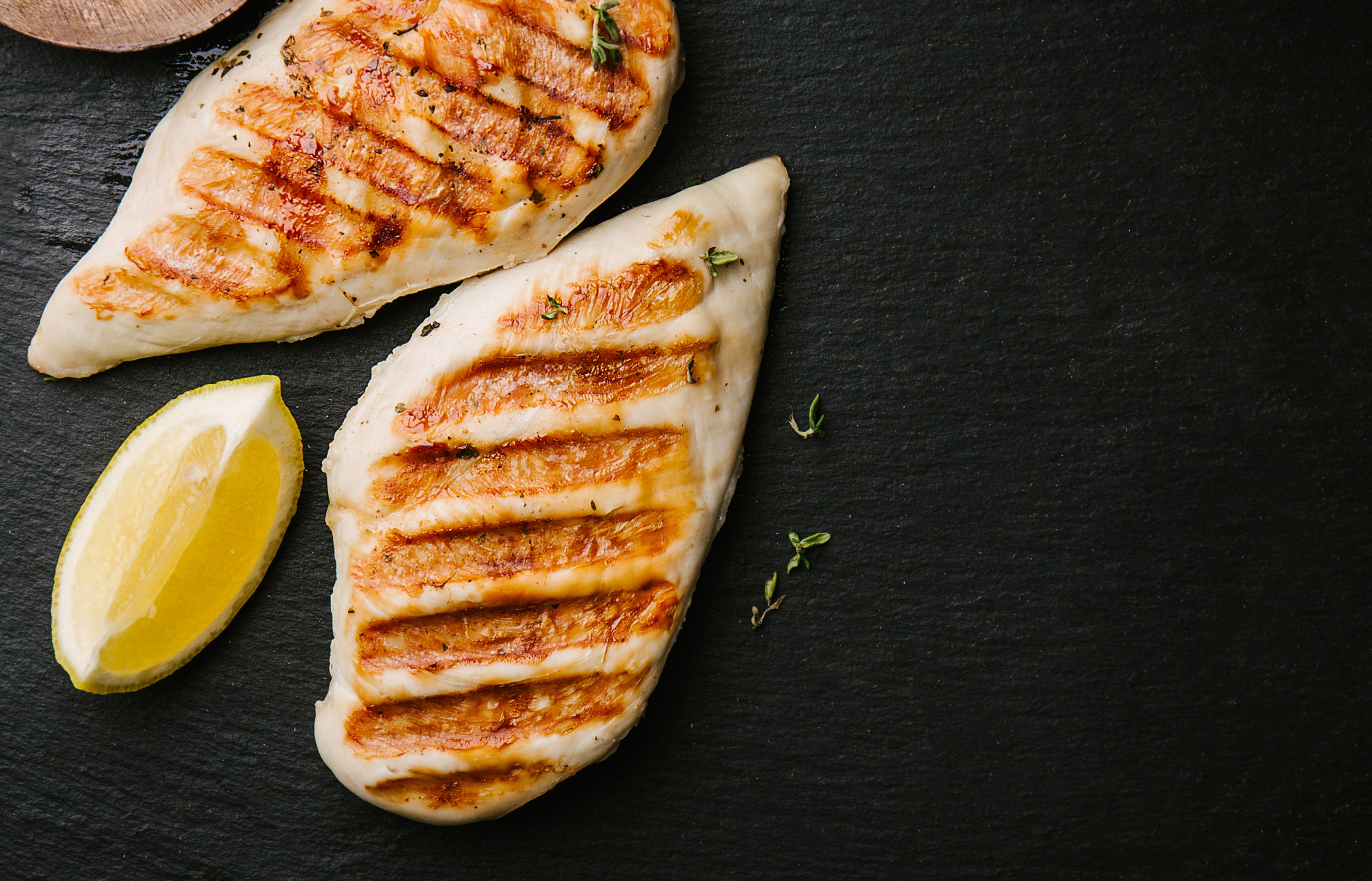- The paleo diet focuses on whole foods eaten by early humans of the Paleolithic era.
- Studies suggest that following a paleo diet may help avoid modern health concerns, like heart disease and diabetes.
- Paleo can help with weight loss but also has some drawbacks, including expense and not being able to enjoy your favorite foods.
The diet that our Paleolithic ancestors ate millions of years ago has made a comeback in modern times, with many people believing that cavemen were onto something.
But following the Paleolithic diet (or paleo for short) isn’t something you should enter into without doing your due diligence.
After all, going paleo would mean giving up some of life’s greatest comfort foods, including bread and cheese.
So, you’ll probably have many questions. What is the paleo diet exactly? What are the rules of paleo? And is the paleo diet healthy?
We got the lowdown about the paleo diet, the pros and cons, and everything else you should know from Noom Wellness Coach Ashley Bannister, MS, RDN.
Note: Consult with your health care provider before making dietary changes.
This is Chapter 1 of Noom's Guide to the Paleo Diet:
- The Noom Kitchen Cookbook: Healthy Living Secrets
- What is the paleo diet? A deep dive for beginners
- Paleo diet for weight loss: FAQs and tips for success
- Paleo food list: What to eat on a paleo diet and what to avoid
- 101 paleo-friendly snacks to make or buy
- Paleo-friendly restaurants: Where to go and what to eat
- The ultimate beginner’s paleo shopping list
- Paleo vs. keto: Which diet is right for you?
- Are potatoes paleo?
- 50 of the best paleo diet recipes for simple, delicious meals
What is the paleo diet?
Paleo—also called the caveman diet, Neanderthal diet, or Stone Age diet—is based on the whole foods we think Paleolithic era humans ate, before agriculture as we know it existed.
Paleolithic hunter-gatherers roamed the land, hunting wild game, catching fish, and foraging for fruits, nuts, seeds, and vegetables.
As humans advanced and industrialized, there’s been a rise in foods that are ultra-processed, cheap, and easy to make, which can increase the rate of chronic diseases, including obesity, heart disease, and diabetes, to name a few.
The thinking behind the paleo diet is that if we revert to a way of eating similar to our ancestors, maybe we can avoid some of the modern health risks that have developed over time. These include type 2 diabetes, certain cancers, and more.
Modern paleo followers typically eat a whole food diet of veggies, fruit, high-quality meat and fish, nuts, eggs, herbs and spices, and more. They avoid processed foods and sugar, grains, legumes, and most dairy products.
A typical paleo meal might consist of a salad of mixed greens topped with oven-roasted salmon, sunflower seeds, and an olive oil dressing. Paleo meals don’t have to be complicated to be nutrient-dense and robust with flavor.
“Because of changes that have taken place to our dietary choices, we can’t really mimic the exact caveman diet,” says Bannister. She recommends focusing on a variety of fruits, vegetables, lean meats, and healthy fats.
Yep, that means no more cupcakes, cheese plates, or happy hour cocktails on paleo.
Origins of the paleo diet
Anthropologists and scientists have been able to recreate what ancient diets from archeological remains, so there is scientific evidence behind knowing what hunter-gatherers ate.
In fact, a type of modern paleo diet is still followed by some tribes around the world.
The popular concept of the paleo diet has been around for quite some time. People started going paleo in the 1970s and the diet gained substantial popularity in 2002 when Loren Cordain’s book, The Paleo Diet: Lose Weight and Get Healthy by Eating the Foods You Were Designed to Eat was published.
Since then, the paleo diet has been followed by celebrities and regular folks alike.
Of the 52% of Americans following a diet or eating plan in 2022, 3% are doing paleo, according to the International Food Information Council’s (IFIC) annual Food and Health Survey.
What did cavemen really eat?
The truth is, we don’t know exactly what Paleolithic hunter-gatherers (or cavemen) ate. Researchers have a decent idea of the basics, but because the Paleolithic era spanned from 2.6 million to 10,000 years ago and covered a wide range of climates, the diets of the Stone Age people likely varied a lot.
It’s thought that cavemen ate fruit, vegetables, meats, seeds, and nuts that they had access to via hunting and gathering, based on their region and climate, according to Bannister.
The humans of the Paleolithic era ate whatever was available to them depending on their geographic location, Bannister says. So, those who lived near the coastline likely ate a diet that included a lot of seafood, while those who lived more inland could have dined on gamier meats. Before the discovery of fire and cooking, these meats were eaten raw.
Bannister says it’s thought that cavemen ate a much wider variety of fruits and vegetables throughout the day than we commonly see in our diet today.
What are the rules of the paleo diet?
There are some basic rules to follow when you’re eating a paleo diet.
- Eat whole foods.
- Paleolithic humans ate foods in their natural state as they found them, in trees, on the ground, or from hunting or fishing. You might not be able to forage for nuts or catch your own fish, but you’ll have to stick with whole foods.
- Choose high-quality meats.
- You’ll eat a lot of meat on paleo, but you should aim for organic and grass-fed meats. As a grain-free diet, you don’t want your meat to come from cows that have been grazing on grains. You also don’t want meat that has any added chemicals in it.
- Avoid all processed foods.
- Processed foods weren’t around when the cavemen roamed the earth and have been linked to an increased rate of chronic diseases. Processed foods have undergone changes to their natural state, including cooking and freezing, according to the U.S. Department of Agriculture (USDA).
- No dairy.
- Dairy isn’t allowed on paleo because it’s an agricultural product—and hunter-gathers didn’t milk cows. This rule includes everything from cow’s milk to your favorite type of cheese, and all the yogurts and creams in between. (Some paleo eaters do claim that milk from grass-fed cows is acceptable.)
- Avoid legumes.
- Hunter-gatherers didn’t have modern farming tools that would have been able to cultivate legumes. Also, paleo eaters say that legumes—including chickpeas, peanuts, and most beans—contain “anti-nutrients” like lectin that can cause health concerns.
- Don’t worry about portion sizes and calories.
- Caveman didn’t. Instead, they listened to their bodies. Modern paleo diet followers are encouraged to adopt the same mindset.
What do you eat on the paleo diet?
Paleo is a very restrictive diet, but the good news is there are lots of whole foods out there for you to enjoy. Not sure whether something is a whole food or not? A good rule of thumb is to avoid food that looks factory-made and stick with options found in nature.
Of course, it’s not always that simple, but it’s a good place to start. Bannister provides some examples of what a paleo diet looks like.
Proteins you’ll eat on paleo include beef, pork, poultry, and seafood. Look for meats that are organic or grass-fed and are free of added hormones or antibiotics. You’ll also be able to pick from plenty of veggies, fruits, eggs, healthy fats, spices, and nuts.
When it comes to the foods you should avoid on a paleo diet, you need to stay away from anything that’s processed.
A food stops being whole and becomes processed when it undergoes any changes to its natural state, including canning, dehydrating, pasteurizing, cooking, freezing, packaging, and more, according to the USDA.
Some of the most restricted foods in a typical paleo diet include legumes and processed products, such as grains, most oils, trans fats, sugars, and artificial sweeteners, according to Bannister.
As with many diets, there is some debate about certain foods and whether or not they fit into a paleo diet. Modified paleo diets have emerged that include “non-paleo” foods, like beans or gluten-free grains.
Basically, these modified paleo diets allow for some wiggle room for foods that have otherwise been designated as healthy but weren’t able to be hunted or gathered during the Paleolithic era.
Some also argue that frozen vegetables can still be considered paleo. Then, there’s the great “Are potatoes paleo?” debate. Some believe the glycemic index and carbohydrate content of white potatoes are too high, and Bannister says that paleo proponents emphasize eating low-glycemic vegetables. However, white potatoes are whole, unprocessed foods—the core idea of what the paleo diet is based on.
We know the paleo diet food dos and don’ts can feel like a lot. So, we’ve made a list of paleo foods for you to know exactly what to eat (and avoid).
Is paleo a low-carb diet?
Because the paleo diet excludes grains, legumes, and processed foods, it often ends up being a low-carb diet, according to Bannister.
A traditional paleo diet is fairly balanced at the end of the day. You’ll be eating vegetables, fish, lean meats, fruits, nuts, and seeds. From this, you’ll get 30% of your energy from protein, 35% from carbohydrates, and 35% from fat, resembling a typical low-carb diet.
Say your recommended calorie intake is 2,000 calories a day. That would mean 600 calories would come from protein sources, 700 calories would come from carbs, and 700 calories would come from fat.
However, the paleo diet isn’t as low-carb as the keto diet, even though paleo and keto do have many similarities.
Low-carb diets have been linked to successful weight loss because you can feel fuller due to the increased intake of fats and protein, and because low-carb diets can result in potential boosts to your metabolism.
Is the paleo diet healthy?
In theory, yes, the paleo diet can be healthy. After all, it focuses on whole foods, cutting out processed products and added sugar, and getting back to basics.
The emphasis on whole foods and less processed products is similar to recommendations in the U.S. government’s dietary guidelines.
However, there aren’t many studies out there specifically about the long-term effects of the paleo diet. This study of more than 21,000 participants suggests a link between the paleo diet and a lowered risk of developing diseases.
Benefits of a paleo diet
The good news is that many of the foods you can eat on a paleo diet are pretty beneficial for you and can be used to make some delicious, good-for-you paleo meals.
Eating whole foods and cutting out added sugar and processed items could lower your risk of developing some chronic health issues.
And there are many more benefits to take into account:
Weight loss
Following the paleo diet could aid in weight loss. This can be at least partly chalked up to the fact that you’re eating a nutrient dense diet that’s high in protein and low-carb.
Improved heart health
While more long-term studies are needed to determine paleo’s true effect on cardiovascular health, some studies found hunter-gatherer tribes from around the world had less prevalence of heart disease.
Short-term research suggests a link between the paleo diet and improved body weight, blood pressure, and biomarkers that could cause cardiovascular disease.
Improved blood sugar control
Going paleo could help lower your risk of developing type 2 diabetes because the diet has been linked to more balanced blood sugar levels.
Improved nutrition
This style of eating emphasizes more veggies and fruit, as well as lean protein, Bannister says. These food groups are full of vital nutrients your body needs not just to survive, but to thrive.
Drawbacks of a paleo diet
Even though the paleo diet involves eating whole foods, there are still some areas of concern you should be aware of before starting.
Nutrient deficiencies
Paleo eliminates whole grains and dairy from the diet. This could lead to nutrient deficiencies, Bannister says, as whole grains are rich in fiber and important nutrients such as B vitamins, iron, folate, selenium, potassium, and magnesium.
Dairy can provide vitamin D as well as calcium, according to Bannister.
High saturated fat intake
On a paleo diet, you’re getting a lot of your protein from animals, which means you’re also likely increasing your intake of high saturated fats.
Eating more high saturated fats could result in increased cholesterol levels and, consequently, a higher risk of heart disease.
Expense
Paleo can come with a hefty price tag. Fresh produce and meats tend to be more expensive than processed foods that are frozen or canned. According to the U.S. Bureau of Labor Statistics, the price of groceries rose 13.5% in 2022—the biggest 12-month increase since 1979.
We’ve compiled some paleo diet grocery shopping tips for you.
Missing out on favorite foods
A paleo diet means you won’t be able to eat a lot of the foods you love. Cutting out the delicious banana bread that your grandmother makes just for you can be traumatic. Not being able to eat your favorite meal at your favorite restaurant on your birthday can be disheartening.
At Noom, we understand that food is a big part of life and not just as fuel for our bodies. Food provides joy, comfort, and socialization.
It can be hard for vegetarians
Vegetarians can do paleo, but it can be pretty difficult as paleo excludes legumes. Some legumes, like beans, are a huge part of vegetarian and vegan diets because they’re good sources of protein and fiber.
Low carbs can be a disadvantage
Carbohydrates are the body’s main source of energy and an important part of a balanced diet, so excluding them could result in lower energy levels.
Hard to sustain
Following paleo can also be unsustainable in the long term due to its restrictiveness and lack of options, according to Bannister.
“When our diets are overly restrictive, we tend to become burnt out with the same foods every day, and that can lead to decision fatigue,” Bannister says.
You may have a difficult time finding a lot of Paleo options at the grocery store, depending on where you live and what’s available seasonally.
Paleo diet for weight loss
Research indicates that the paleo diet could be an effective way to lose weight.
At Noom, we don’t recommend restrictive diets, but we do believe in the power of whole foods that give you important nutrients, leave you feeling satisfied, and help you meet your goals.
And Bannister confirms that you can lose weight on paleo if you follow the diet in an intentional, mindful way. But following the diet alone doesn’t guarantee weight loss.
“It’s not necessarily true that you will lose weight if you cut those foods out,” Bannister says. “It’s more accurate to say that if you cut those foods out and don’t replace them with extra calories elsewhere in your diet, then it will lead to weight loss.”
Need more guidance on losing weight on paleo? We’re here to help!



